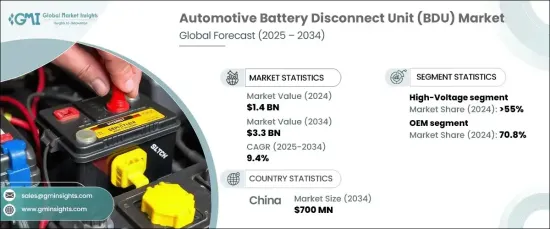
세계의 자동차 배터리 디스커넥트 유닛 시장 규모는 2024년 14억 달러였고, 2025년부터 2034년까지 연평균 복합 성장률(CAGR) 9.4%의 현저한 성장이 예측되고 있습니다.
이러한 성장을 뒷받침하는 것은 BDU 기술의 발전, 특히 스마트 모니터링 시스템의 통합입니다. 최신 BDU에는 최첨단 센서와 사물인터넷(IoT) 기능이 탑재되어 전압, 전류, 온도의 실시간 감시가 가능합니다. 이러한 혁신은 차량의 안전성과 성능을 크게 향상시켜 BDU를 현대 자동차 시스템에 필수적인 구성 요소로 만듭니다.

신흥 시장에서 전기자동차(EV)의 급속한 보급은 고급 BDU 수요 증가의 주요 촉진요인이 되고 있습니다. 각국이 전동 이동성으로의 전환을 가속화하는 동안 비용 효율적이고 확장성이 있으며 기후 변화에 강한 BDU의 요구가 증가하고 있습니다. 세계 각국의 정부는 EV 장려책이나 충전 인프라의 급속한 확대 등 지원 정책에 의해 이 기세에 박차를 가하고 있습니다. 이 시프트는 다양한 조건과 환경에서 안정적으로 작동하도록 설계된 BDU 수요를 더욱 두드러지게 합니다.
| 시장 범위 | |
|---|---|
| 시작년 | 2024년 |
| 예측연도 | 2025-2034년 |
| 시작금액 | 14억 달러 |
| 예측 금액 | 33억 달러 |
| CAGR | 9.4% |
전압별로 분할하면 시장은 고전압 BDU와 저전압 BDU로 구성됩니다. 고전압 BDU는 전기자동차와 하이브리드 자동차에서 매우 중요한 역할을 반영하여 2024년 시장 점유율의 55%를 차지했습니다. 이러한 BDU는 단락과 같은 전기적 위험을 방지하고 안전을 보장하면서 EV 배터리 시스템에서 에너지를 관리하고 저장하는 데 중요합니다. 안전 규제가 강화되고 승용차와 상용차 모두에서 고성능 배터리 시스템에 대한 주목이 높아짐에 따라 고전압 BDU 수요는 향후 수년간 크게 성장할 것으로 예상됩니다.
이 시장은 또한 유통 채널별로 상대방 상표 제품 제조업체(OEM)와 애프터마켓으로 분류됩니다. 2024년에는 OEM이 70.8% 시장 점유율을 차지했고 신차에 BDU가 표준 부품으로 통합되어 있는 것이 그 요인이었습니다. OEM은 규모의 경제를 활용하여 고품질의 BDU를 경쟁력 있는 가격으로 제공하며 첨단 안전성과 자동화 기술에 대한 수요 증가에 대응하고 있습니다. 지속적인 혁신과 공급업체 간의 전략적 제휴로 BDU 기술은 더욱 강화되고 진화하는 규제 기준과 소비자의 선호도에 부합합니다.
중국은 자동차용 BDU 시장의 강국으로 부상하고 있으며, 2034년까지 7억 달러에 이를 것으로 예측됩니다. 자동차 제조의 세계 리더인 중국은 자동차 제조업체가 EV 제품에서 안전성, 에너지 효율, 성능을 우선시하고 있기 때문에 BDU 수요가 급증하고 있습니다. 이 지역의 급속한 도시화는 가처분 소득 증가와 함께 자동차 판매와 첨단 자동차 기술의 채용을 촉진하고 있으며, BDU 시장의 향후 성장에 중요한 국가로서 중국의 지위를 확고하게 하고 있습니다.
The Global Automotive Battery Disconnect Unit Market was valued at USD 1.4 billion in 2024 and is forecasted to grow at a remarkable CAGR of 9.4% between 2025 and 2034. This growth is propelled by advancements in BDU technology, particularly the integration of smart monitoring systems. Modern BDUs are now equipped with cutting-edge sensors and Internet of Things (IoT) capabilities, enabling real-time monitoring of voltage, current, and temperature. These innovations significantly enhance vehicle safety and performance, making BDUs an indispensable component of modern automotive systems.

The surging adoption of electric vehicles (EVs) in emerging markets is a key driver behind the increasing demand for advanced BDUs. As nations accelerate their transition to electric mobility, the need for cost-effective, scalable, and climate-resilient BDUs is on the rise. Governments worldwide are fueling this momentum with supportive policies, including EV incentives and the rapid expansion of charging infrastructure. This shift further underscores the demand for BDUs engineered to operate reliably across diverse conditions and environments.
| Market Scope | |
|---|---|
| Start Year | 2024 |
| Forecast Year | 2025-2034 |
| Start Value | $1.4 Billion |
| Forecast Value | $3.3 Billion |
| CAGR | 9.4% |
Segmented by voltage, the market comprises high-voltage and low-voltage BDUs. High-voltage BDUs accounted for 55% of the market share in 2024, reflecting their pivotal role in electric and hybrid vehicles. These BDUs are critical for managing and storing energy in EV battery systems while ensuring safety by preventing electrical hazards such as short circuits. With stricter safety regulations and a growing focus on high-performance battery systems for both passenger and commercial vehicles, the demand for high-voltage BDUs is expected to witness substantial growth in the coming years.
The market is also categorized by distribution channel into original equipment manufacturers (OEMs) and the aftermarket. In 2024, OEMs dominated with a 70.8% market share, driven by the incorporation of BDUs as standard components in new vehicles. OEMs leverage economies of scale to deliver high-quality BDUs at competitive prices, meeting the rising demand for advanced safety and automation technologies. Continuous innovation and strategic collaborations with suppliers further enhance BDU technology, ensuring it aligns with evolving regulatory standards and consumer preferences.
China is emerging as a powerhouse in the automotive BDU market, projected to reach USD 700 million by 2034. As a global leader in automotive manufacturing, China is experiencing a surge in demand for BDUs as automakers prioritize safety, energy efficiency, and performance in their EV offerings. The region's rapid urbanization, coupled with increasing disposable incomes, is driving vehicle sales and the adoption of advanced automotive technologies, solidifying China's position as a key player in the BDU market's future growth.